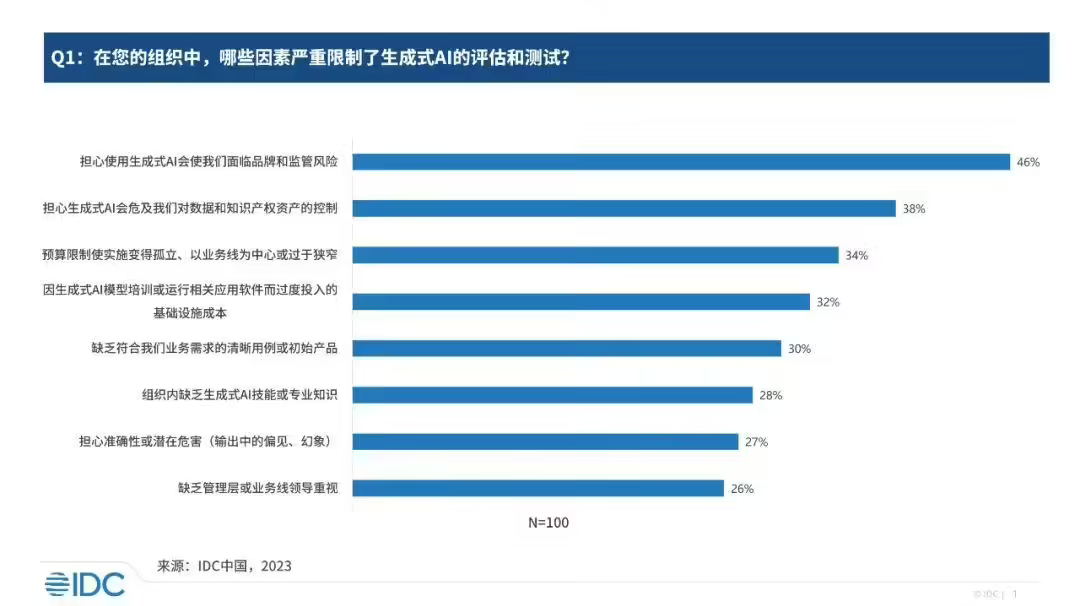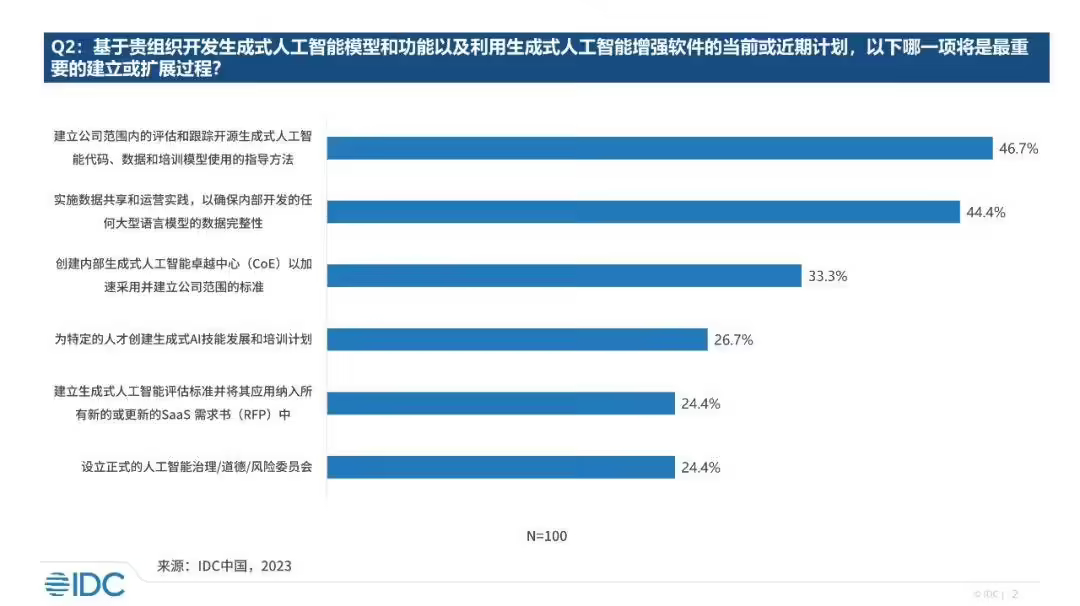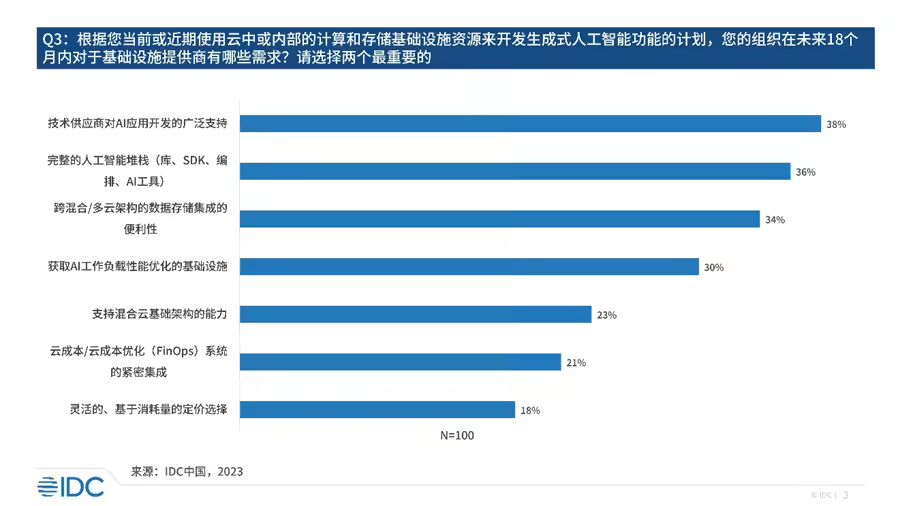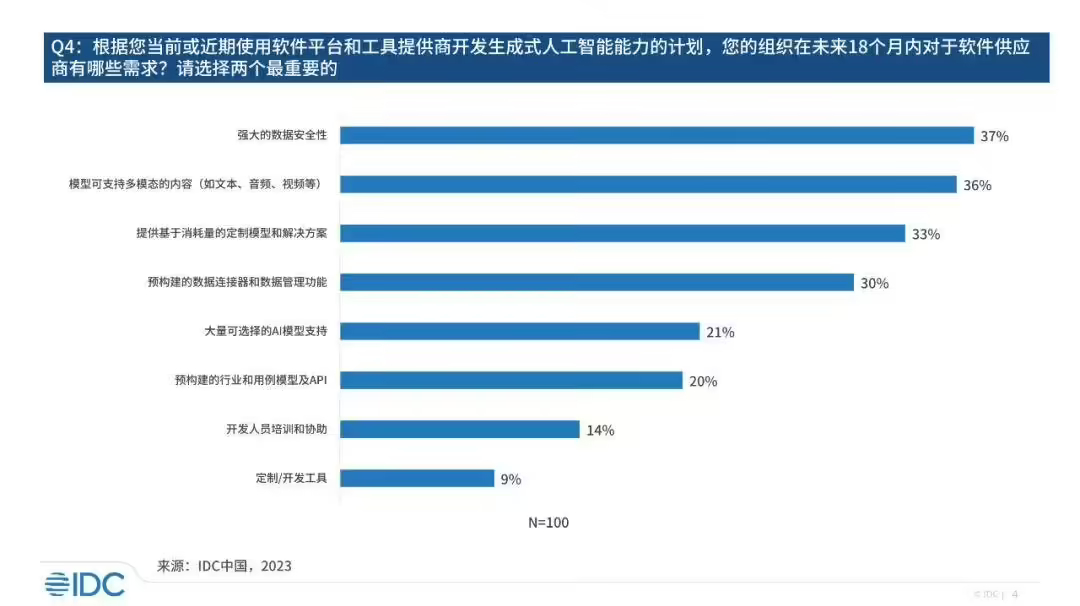 Technology peripherals
Technology peripherals
 AI
AI
 IDC report: Generative AI has entered an explosive period of industry exploration, and the technology supply side is in the early stages of commercialization
IDC report: Generative AI has entered an explosive period of industry exploration, and the technology supply side is in the early stages of commercialization
IDC report: Generative AI has entered an explosive period of industry exploration, and the technology supply side is in the early stages of commercialization

According to the introduction of IDC Consulting’s official public account, since the second half of 2023, more and more manufacturers have begun to update and upgrade generative artificial intelligence-related products and accelerate the integration of these products. Bringing it to the market
In order to deeply understand the needs, pain points and market status of China's generative AI users, IDC conducted a survey in order to "provide strong support for the future development of the industry. In order to maintain the original intention, the content needs to be Rewritten into Chinese. No original sentence required."
This site summarizes the IDC report as follows:
On the industry user side, generative AI has entered an exploratory period
- Industry users should avoid blind obedience. Strengthen management. Although there are currently obstacles such as brand and regulatory risks, data and intellectual property protection, budget and cost, the implementation timetable of the initially explored generative AI applications has not yet been clear, but the entire market continues to have a strong interest in generative AI technology. Introduce, express acceptance and recognition.
- Industry users should avoid potential risks. Enterprises can prioritize the establishment of evaluation and guidance methods for generative AI technology, as well as strengthen collaborative practices for application cases and data sharing, and introduce third parties to the application development process. Regulate potential ethical and legal risks arising from generative AI applications.
 ▲ Picture source IDC Consult the official public account
▲ Picture source IDC Consult the official public account
 ▲ Picture source IDC Consult the official public account
▲ Picture source IDC Consult the official public account
On the technology supplier side, generative AI has entered the early stage of commercialization
- Technology supply for different roles Businesses should avoid technology anxiety and pay attention to product upgrades.
- AI infrastructure vendors should provide extensive development support and complete AI stack (including libraries, SDKs, orchestration, AI tools), in addition to supporting data across hybrid/multi-cloud architectures Storage integration.
- AI software suppliers should provide AI products with data security and support for multi-modal content (such as text, audio, video, etc.); in addition, they should also consider providing industry-customized models and solutions Program, data management and other functions.
 ▲ Picture source IDC Consult the official public account
▲ Picture source IDC Consult the official public account
 ▲ Picture source IDC Consult the official public account
▲ Picture source IDC Consult the official public account
#In order to keep the original meaning unchanged, the content needs to be rewritten into Chinese. There is no need to appear the original sentence
requiredThe above is the detailed content of IDC report: Generative AI has entered an explosive period of industry exploration, and the technology supply side is in the early stages of commercialization. For more information, please follow other related articles on the PHP Chinese website!

Hot AI Tools

Undresser.AI Undress
AI-powered app for creating realistic nude photos

AI Clothes Remover
Online AI tool for removing clothes from photos.

Undress AI Tool
Undress images for free

Clothoff.io
AI clothes remover

AI Hentai Generator
Generate AI Hentai for free.

Hot Article

Hot Tools

Notepad++7.3.1
Easy-to-use and free code editor

SublimeText3 Chinese version
Chinese version, very easy to use

Zend Studio 13.0.1
Powerful PHP integrated development environment

Dreamweaver CS6
Visual web development tools

SublimeText3 Mac version
God-level code editing software (SublimeText3)

Hot Topics
 1382
1382
 52
52
 Centos shutdown command line
Apr 14, 2025 pm 09:12 PM
Centos shutdown command line
Apr 14, 2025 pm 09:12 PM
The CentOS shutdown command is shutdown, and the syntax is shutdown [Options] Time [Information]. Options include: -h Stop the system immediately; -P Turn off the power after shutdown; -r restart; -t Waiting time. Times can be specified as immediate (now), minutes ( minutes), or a specific time (hh:mm). Added information can be displayed in system messages.
 What are the backup methods for GitLab on CentOS
Apr 14, 2025 pm 05:33 PM
What are the backup methods for GitLab on CentOS
Apr 14, 2025 pm 05:33 PM
Backup and Recovery Policy of GitLab under CentOS System In order to ensure data security and recoverability, GitLab on CentOS provides a variety of backup methods. This article will introduce several common backup methods, configuration parameters and recovery processes in detail to help you establish a complete GitLab backup and recovery strategy. 1. Manual backup Use the gitlab-rakegitlab:backup:create command to execute manual backup. This command backs up key information such as GitLab repository, database, users, user groups, keys, and permissions. The default backup file is stored in the /var/opt/gitlab/backups directory. You can modify /etc/gitlab
 How to check CentOS HDFS configuration
Apr 14, 2025 pm 07:21 PM
How to check CentOS HDFS configuration
Apr 14, 2025 pm 07:21 PM
Complete Guide to Checking HDFS Configuration in CentOS Systems This article will guide you how to effectively check the configuration and running status of HDFS on CentOS systems. The following steps will help you fully understand the setup and operation of HDFS. Verify Hadoop environment variable: First, make sure the Hadoop environment variable is set correctly. In the terminal, execute the following command to verify that Hadoop is installed and configured correctly: hadoopversion Check HDFS configuration file: The core configuration file of HDFS is located in the /etc/hadoop/conf/ directory, where core-site.xml and hdfs-site.xml are crucial. use
 How is the GPU support for PyTorch on CentOS
Apr 14, 2025 pm 06:48 PM
How is the GPU support for PyTorch on CentOS
Apr 14, 2025 pm 06:48 PM
Enable PyTorch GPU acceleration on CentOS system requires the installation of CUDA, cuDNN and GPU versions of PyTorch. The following steps will guide you through the process: CUDA and cuDNN installation determine CUDA version compatibility: Use the nvidia-smi command to view the CUDA version supported by your NVIDIA graphics card. For example, your MX450 graphics card may support CUDA11.1 or higher. Download and install CUDAToolkit: Visit the official website of NVIDIACUDAToolkit and download and install the corresponding version according to the highest CUDA version supported by your graphics card. Install cuDNN library:
 Centos install mysql
Apr 14, 2025 pm 08:09 PM
Centos install mysql
Apr 14, 2025 pm 08:09 PM
Installing MySQL on CentOS involves the following steps: Adding the appropriate MySQL yum source. Execute the yum install mysql-server command to install the MySQL server. Use the mysql_secure_installation command to make security settings, such as setting the root user password. Customize the MySQL configuration file as needed. Tune MySQL parameters and optimize databases for performance.
 Detailed explanation of docker principle
Apr 14, 2025 pm 11:57 PM
Detailed explanation of docker principle
Apr 14, 2025 pm 11:57 PM
Docker uses Linux kernel features to provide an efficient and isolated application running environment. Its working principle is as follows: 1. The mirror is used as a read-only template, which contains everything you need to run the application; 2. The Union File System (UnionFS) stacks multiple file systems, only storing the differences, saving space and speeding up; 3. The daemon manages the mirrors and containers, and the client uses them for interaction; 4. Namespaces and cgroups implement container isolation and resource limitations; 5. Multiple network modes support container interconnection. Only by understanding these core concepts can you better utilize Docker.
 Centos8 restarts ssh
Apr 14, 2025 pm 09:00 PM
Centos8 restarts ssh
Apr 14, 2025 pm 09:00 PM
The command to restart the SSH service is: systemctl restart sshd. Detailed steps: 1. Access the terminal and connect to the server; 2. Enter the command: systemctl restart sshd; 3. Verify the service status: systemctl status sshd.
 How to view GitLab logs under CentOS
Apr 14, 2025 pm 06:18 PM
How to view GitLab logs under CentOS
Apr 14, 2025 pm 06:18 PM
A complete guide to viewing GitLab logs under CentOS system This article will guide you how to view various GitLab logs in CentOS system, including main logs, exception logs, and other related logs. Please note that the log file path may vary depending on the GitLab version and installation method. If the following path does not exist, please check the GitLab installation directory and configuration files. 1. View the main GitLab log Use the following command to view the main log file of the GitLabRails application: Command: sudocat/var/log/gitlab/gitlab-rails/production.log This command will display product



